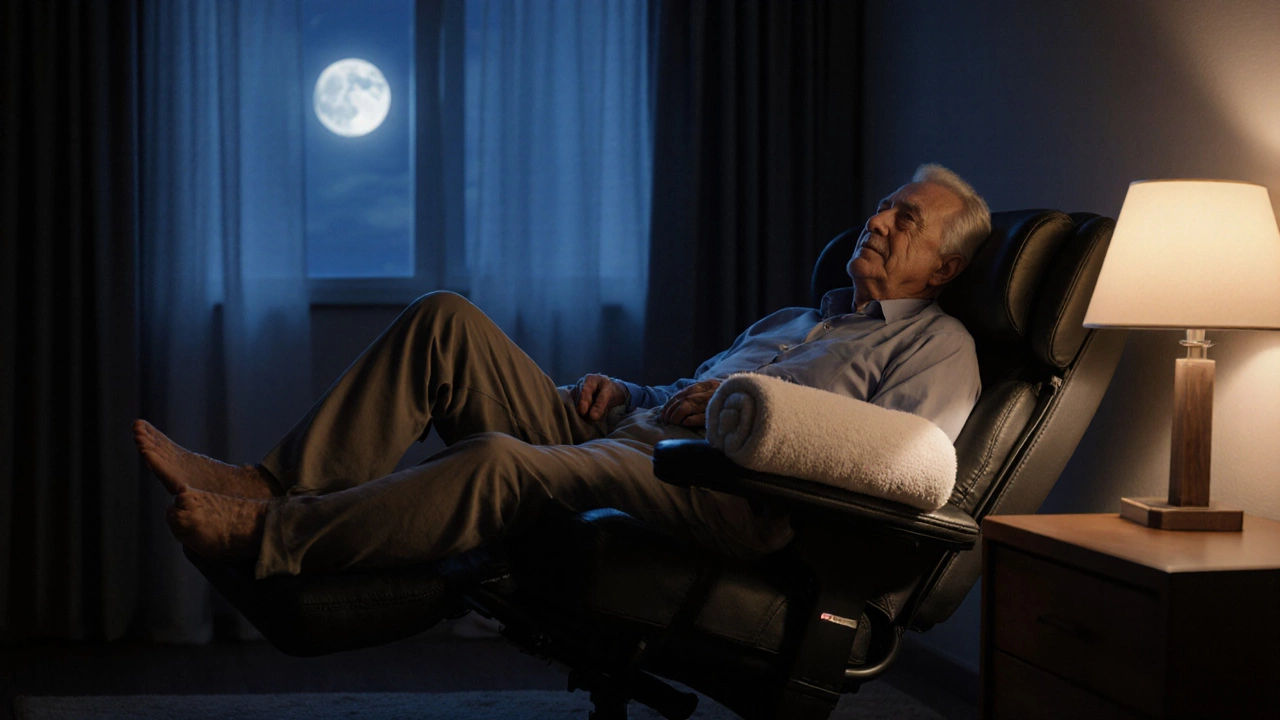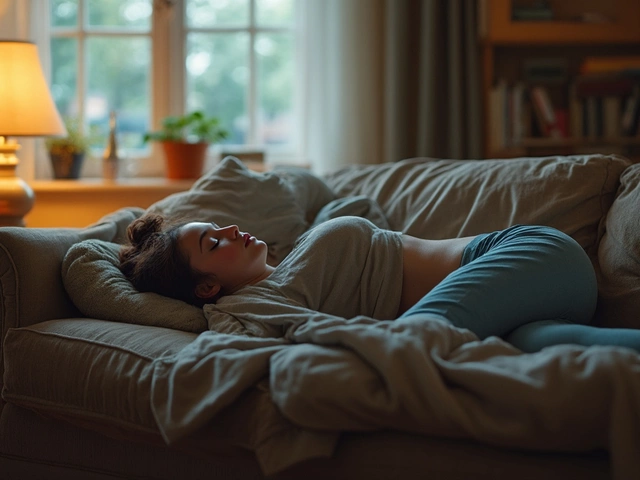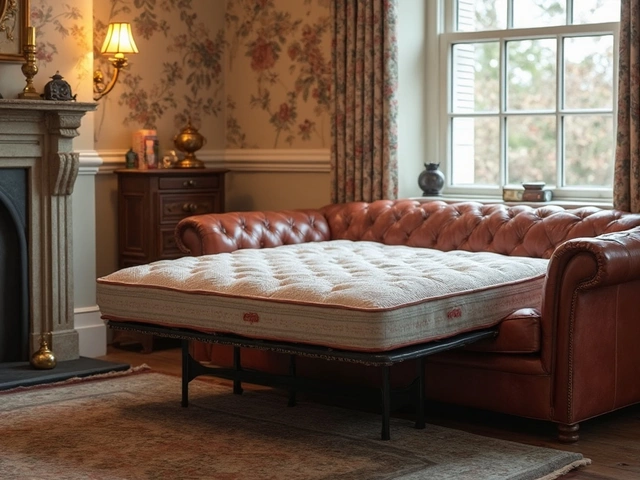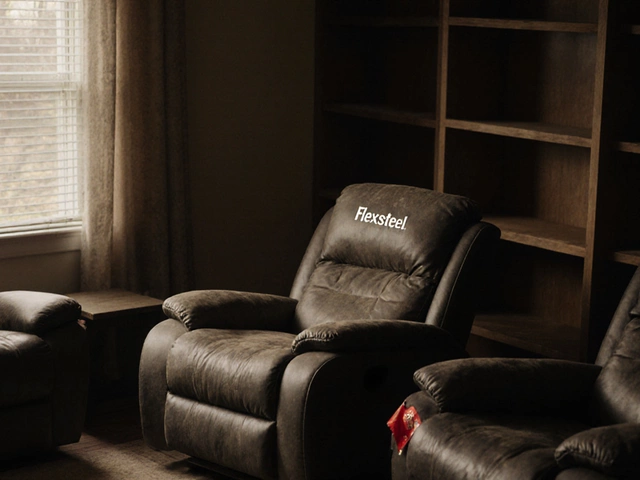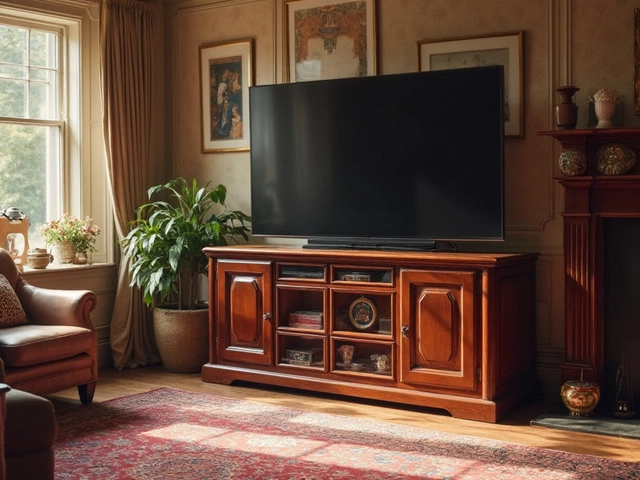Recliner Safety Calculator
How Safe Is Your Recliner Sleep?
Answer these questions to determine your personal risk level. Your results will help you understand if you need to adjust your sleeping position or seek medical advice.
Your Recliner Safety Assessment
Many people swear by sleeping in a recliner-especially after a long day, during pregnancy, or when dealing with back pain or snoring. But if you’ve been doing it every night, you might be wondering: is this actually okay for your body? The short answer? It’s not ideal for long-term health, but it’s not always dangerous either. It depends on your posture, your chair, and your underlying health.
Why People Choose to Sleep in Recliners
There are real reasons why sleeping in a recliner feels better than lying flat. People with acid reflux often find relief because the elevated head keeps stomach acid down. Those with sleep apnea or chronic snoring benefit from the open airway that comes with being slightly upright. Pregnant women frequently report less pressure on their lower back and pelvis. And after surgery or injury, a recliner can be the only comfortable position for weeks.
One 2023 study from the University of Auckland’s Sleep Research Lab found that 18% of adults over 55 who reported chronic back pain used a recliner as their primary sleeping surface. For many, it’s not a preference-it’s a necessity.
What Happens to Your Body When You Sleep in a Recliner Every Night
Human bodies evolved to sleep horizontally. Our spine, muscles, and joints are designed to distribute weight evenly across a flat surface. A recliner, even a high-end one, forces your body into a fixed, angled position for hours. Over time, this can cause problems.
- Spinal misalignment: Most recliners don’t support the natural curve of your lower back. This leads to increased pressure on the lumbar discs, which can cause chronic pain or even herniation.
- Muscle stiffness: Your hip flexors and hamstrings stay shortened in a reclined position. This tightness can pull on your pelvis and lower spine, making it harder to stand up straight in the morning.
- Poor circulation: If your legs are elevated but bent at awkward angles, blood flow can be restricted. This increases the risk of swelling or even deep vein thrombosis in high-risk individuals.
- Disrupted sleep cycles: Recliners often lack the full-body support needed for deep REM sleep. You may wake up more often without realizing it, leading to daytime fatigue.
One 65-year-old patient from Christchurch, who slept in his recliner for 12 years, developed severe hip flexor contractures. He couldn’t walk without a cane until physical therapy helped him stretch and retrain his muscles.
When Sleeping in a Recliner Might Be Okay
It’s not all bad. If you’re using a recliner temporarily-say, after a knee replacement or during a bad cold-it’s fine. Even long-term, some people can manage it safely if they take steps to reduce the risks.
Here’s what works for those who need to sleep in a recliner:
- Choose a zero-gravity recliner: These models elevate your legs to heart level and tilt your torso slightly backward. This mimics the weightless position astronauts use, reducing pressure on the spine and improving circulation.
- Add lumbar support: Roll up a towel or use a small cushion behind your lower back. This helps maintain the natural curve of your spine.
- Change positions: Don’t stay in the same angle all night. Adjust the recline every few hours, or alternate nights between the recliner and your bed.
- Stretch daily: Do hip flexor stretches, hamstring rolls, and gentle spinal twists every morning. This counteracts the tightness caused by prolonged sitting.
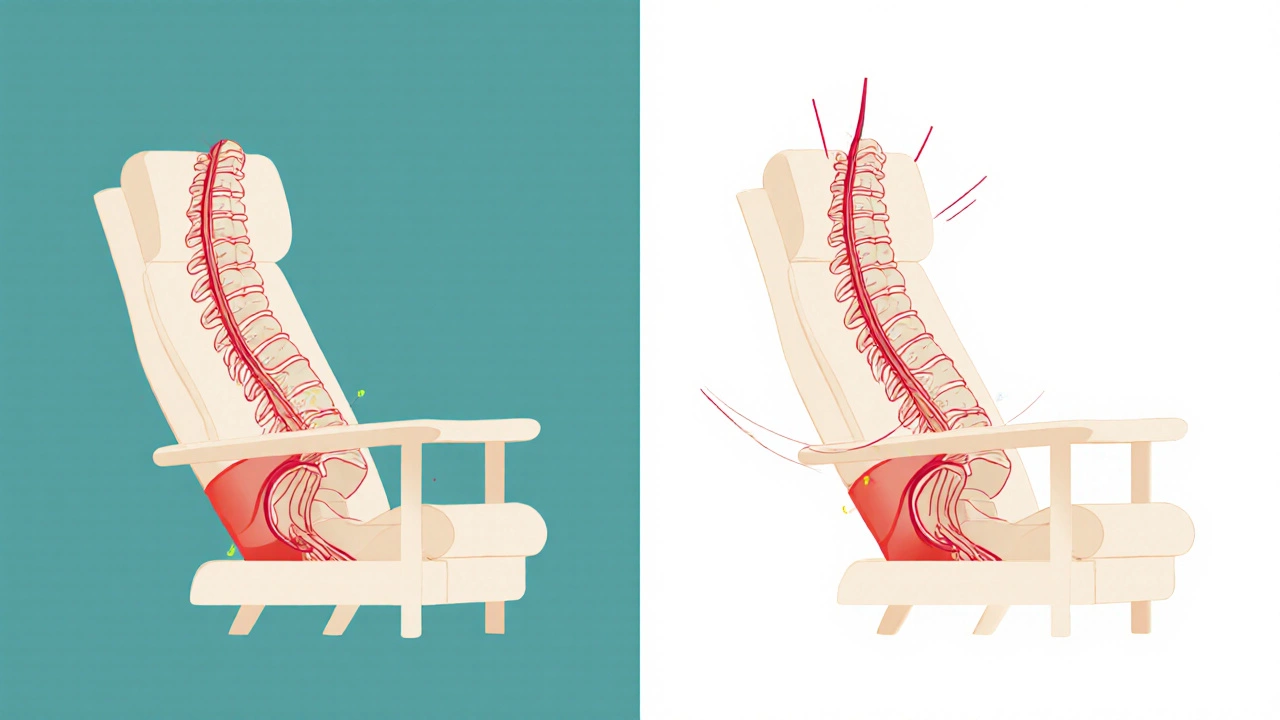
What to Avoid
Some habits make sleeping in a recliner much riskier:
- Using a basic recliner with no leg support: If your feet dangle or your knees are bent at 90 degrees, you’re putting strain on your lower back and knees.
- Sleeping in the same position every night: Your body needs movement during sleep. Staying locked in one angle increases stiffness and joint degeneration.
- Ignoring pain: If you wake up with numbness, tingling, or sharp pain in your legs or back, that’s your body screaming for change.
- Relying on it because your bed is uncomfortable: If your mattress is the problem, fix that instead. A worn-out mattress causes more harm than a recliner ever will.
Recliner vs. Bed: What the Experts Say
Orthopedic specialists and sleep doctors agree: a supportive, flat mattress is still the gold standard. But they also recognize that for some people, a recliner is a better option than no sleep at all.
The American Academy of Sleep Medicine doesn’t list recliners as a recommended sleep surface, but they do acknowledge that positional therapy (sleeping elevated) is a valid treatment for sleep apnea and GERD. For those patients, a recliner with proper support can be part of a treatment plan.
Dr. Lisa Chen, a sleep physician in Wellington, says: “I’ve seen patients who couldn’t sleep in bed at all-until we adjusted their recliner with proper support. It’s not perfect, but if it gives them 6 hours of restful sleep, that’s better than 2 hours of tossing and turning.”
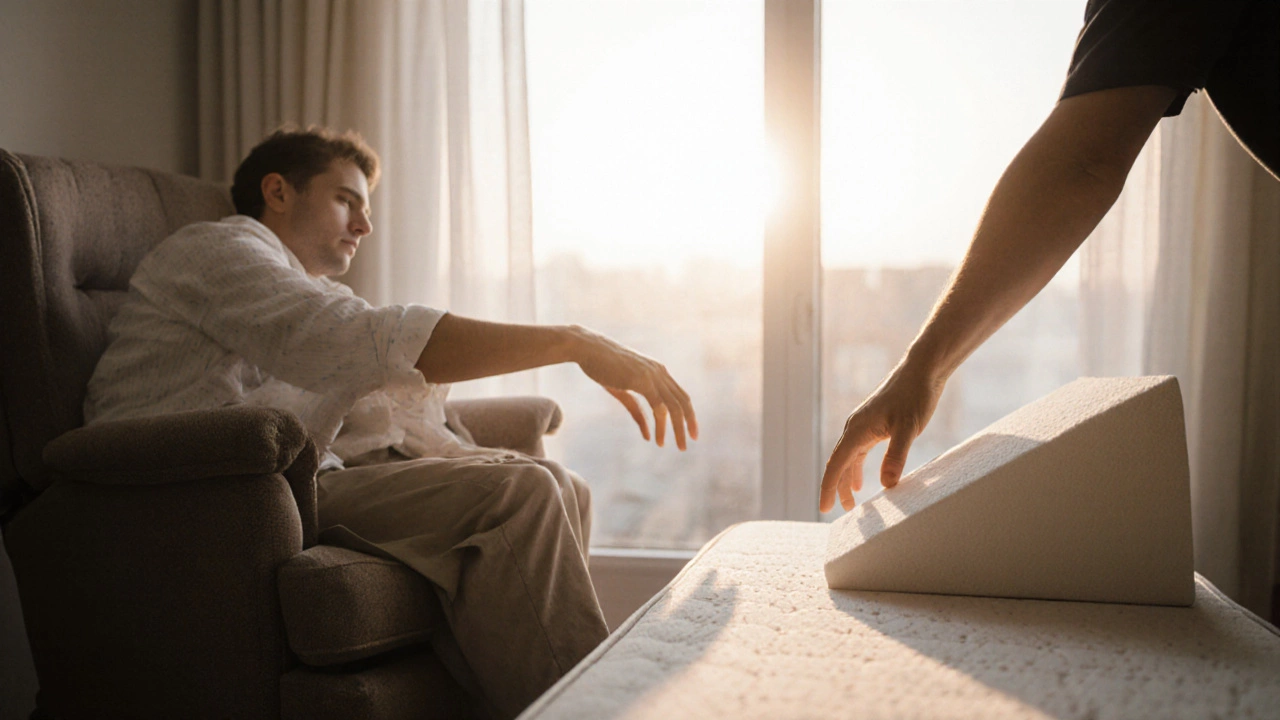
Alternatives to Sleeping in a Recliner
If you’re using a recliner because your bed hurts, try these fixes first:
- Upgrade your mattress: Memory foam or hybrid mattresses with medium-firm support help most back and hip pain sufferers.
- Add a wedge pillow: A 6-inch foam wedge under your upper body can mimic the elevation of a recliner without the posture issues.
- Try an adjustable bed: These cost more than a recliner but offer full-body support, customizable angles, and better long-term ergonomics.
- Use a floor mat with a bolster: Some people with severe back pain find relief sleeping on a firm mat with a pillow under their knees and another behind their lower back.
When to See a Doctor
Don’t ignore these signs:
- Waking up with numbness or pins-and-needles in your legs
- Chronic lower back pain that doesn’t improve with stretching
- Difficulty standing up straight after sleeping
- Swelling in your ankles or calves
- Snoring that’s gotten worse or you’re gasping for air at night
These could point to sleep apnea, spinal degeneration, or circulation issues-all treatable if caught early.
Final Verdict
Sleeping in a recliner every night isn’t recommended for healthy adults. But if you have a medical reason, it’s not the end of the world. The key is to make it as safe as possible-use the right chair, support your spine, stretch daily, and don’t ignore warning signs.
If you can switch back to a bed-even with a wedge or new mattress-that’s the best path forward. But if your recliner is the only thing giving you restful sleep, don’t feel guilty. Just make sure you’re doing everything you can to protect your body while you’re using it.
Can sleeping in a recliner cause back pain?
Yes, if the recliner doesn’t support your lower back properly. Sitting at an angle for hours without lumbar support can strain your spine, tighten your hip muscles, and lead to chronic pain. Using a cushion behind your lower back and choosing a zero-gravity model can help reduce this risk.
Is a zero-gravity recliner better for sleeping?
Yes. Zero-gravity recliners position your body so your legs are elevated to heart level and your torso is slightly tilted back. This reduces pressure on your spine, improves circulation, and helps with breathing. It’s the closest thing to a healthy alternative to a flat bed if you must sleep in a recliner.
Can you get blood clots from sleeping in a recliner?
It’s rare, but possible. If you’re immobile for long periods with your legs bent or dangling, blood flow can slow down, increasing the risk of deep vein thrombosis (DVT). This is more likely if you’re over 60, overweight, pregnant, or have a history of clots. Move your legs occasionally, wear compression socks if needed, and avoid crossing your ankles.
Is it better to sleep in a recliner or on the floor?
For most people, a supportive mattress is best. But if you have severe back pain, a firm floor mat with pillows under your knees and lower back can be better than a poorly designed recliner. A recliner offers more comfort and support than the floor, but only if it’s properly adjusted and supported.
Should I buy an adjustable bed instead of using a recliner?
If you’re using a recliner every night because your bed is uncomfortable, an adjustable bed is a smarter long-term investment. It gives you the same elevation benefits as a recliner but with full-body support, better alignment, and no risk of muscle stiffness from sitting in one position. They’re more expensive, but they last longer and are better for your spine.
